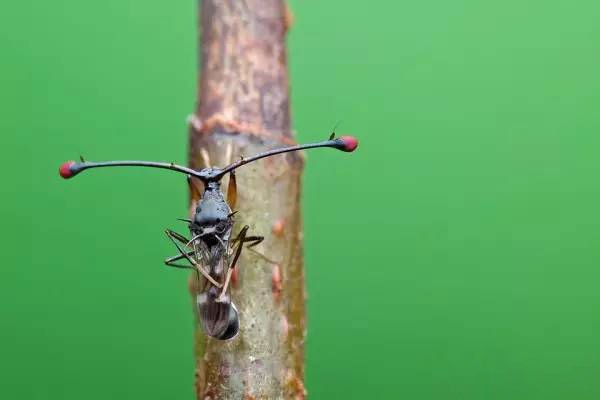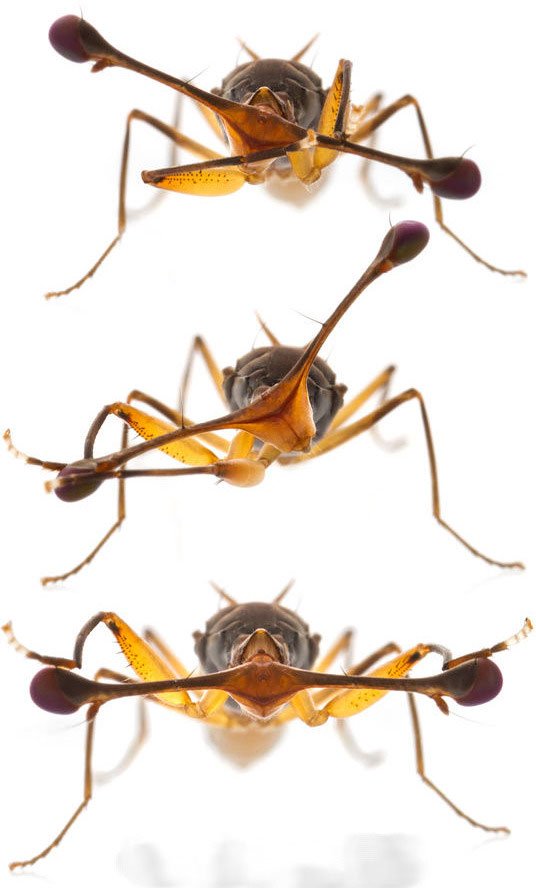Eye stalks: Animals possess the most unusual bulging eyes in the wild
If you see an insect with big eyes like aliens in fiction movies, don't worry, they are a strange "work" of nature.
Its strange appearance and unique survival habits make this creature "salty" enough to be listed as one of the strangest insects in the world.

This small but strange creature is mainly found in the rainforests of Southeast Asia, Africa and a few in Europe and North America.Their name is based on having long sections protruding from the sides of the head with eyes and antennae at the end.Males often have much longer eye stalks than females, and biologists have determined that females prefer long-stemmed "eyes".
Stalk-eyed flies (Stalk-eyed flies) belong to the Diopsidae family, they are different from other flying insects in their long-stemmed eyes. This stem protrudes from the sides of the head and the eyes are located at the end of the stem.
Especially as the stalk distance of females often tends to be longer in males when mature and their life cycle is very short, counting the time since they are eggs and the larvae and adults only wrap up within eight weeks.

This stem protrudes from the sides of the head and the eyes are located at the end of the stem.
During the mating season, the males often stand face to face and measure their eye length. The one with the furthest "eye span" will be declared the winner. Males also have the extraordinary ability to enlarge their eye stalks by swallowing air through their mouths and blowing it through a duct into the ends of their eyes. They mainly do this during mating season.
Although some insects possess a similarly shaped head, their broadcast antennae grow in the center of the head, but the stalks are completely different, their parts are located. on the stem and it is also an important feature to distinguish this species from other insects.


The species of fly belongs to the family Diopsidae.
So far, scientists have discovered and known more than 100 species of Diopsidae - most of them possess unique and completely different eyes than those of the insect world. coincide.
They are usually distributed in tropical regions in Europe, Asia, Africa and a few in North America, of which the most famous species of the Diopsidae family live in Southeast Asia and South Africa. In addition, the strange appearance of this creature also helps scientists easily distinguish fossils of some ancient insects, typically Prosphyracephala - a genus of Diopsidae. This genus is thought to be extinct and is known from specimens in the Baltic amber.

Adult eye stalks are often found in humid environments.
Adult eye-sting flies are often found in humid environments near creeks or rivers because this is an ideal environment for "stinking" vegetation and bacteria from the "stinking" vegetation to grow - a food source They also eat a number of other plants in the environment. In Africa, a species of stalked fly was found in 1817, called Diopsis macrophthalma, which is a devastating pest that feeds on wet rice as well as sorghum.

With strange eyes, this fly has an extremely wide view.
Owning a pair of strange eyes with extended stalks is also an advantage for this exotic fly with an extremely wide view, in addition to the dual eyes made up of 2,500 small eyes ( visual sensing) which is very beneficial for finding food as well as finding enemies in your surroundings.

They also have dual eyes made up of 2,500 small eyes.
Moreover, the exotic eyes of this fly also have a special function during the mating season, the males often face to face and measure the length of their eyes. The one with the furthest "eye span" will be declared the winner. Males also have the extraordinary ability to enlarge their eye stalks by swallowing air through their mouths and blowing it through a duct into the ends of their eyes. They mainly do this during mating season.

Males often enlarge their eyes at mating season.
In fact, the act of achieving mating rights by comparing the length and size of a given body part does not just happen to every species of trachoma. Many other animals in nature also use this method as a criterion for selecting a mate. This phenomenon is called evolutionary sex selection and refers to the competition between individuals of the same sex (usually males) for the opportunity to mate which will promote the evolution of traits. personal.
The stalk fly is considered a prime example of an animal exhibiting sex selection characteristics. The selective behavior of males with longer stalks will result in genetic changes, so the genes that influence the traits of the iris and the genes that females like will pass on to the offspring. theirs.

The choice of mating partner of female eye stalks is influenced by genetics.
The researchers collected a number of trachoma flies, measured eye distance, body length, age and fertility of all of them and observed their behavioral characteristics in experimental environment.
After 13 generations of artificial selection, the researchers found that females with parents with long stalks were more likely to mate with males with long bodies, while females with short-eyed fathers would attracted to males with short stems and males with wider eye gaps would not be selected. This also confirms that the choice of mating partner of the female eye stalks is influenced by genetics.
- The unusual eyes of animals (II)
- Photography: 'Talking eyes' of wild animals
- The most unusual eyes of animals (I)
- The sharp eyes of animals
- The power of animal eyes
- Why do animals with large eyes run faster?
- The image is amazed about the animal's eyes
- Shrimp possess the most complex vision of any animal
- Lime leaves, medicinal plants
- American wild boar 'invades' Mexico
- 7 differences between animals and wild animals
- Why did Australia destroy 2 million cats?
 Why do potatoes have eyes?
Why do potatoes have eyes? 'Tragedy' the world's largest carnivorous life: Death becomes ... public toilet
'Tragedy' the world's largest carnivorous life: Death becomes ... public toilet Tomatoes were once considered 'poisonous' for 200 years
Tomatoes were once considered 'poisonous' for 200 years Detecting microscopic parasites on human face
Detecting microscopic parasites on human face